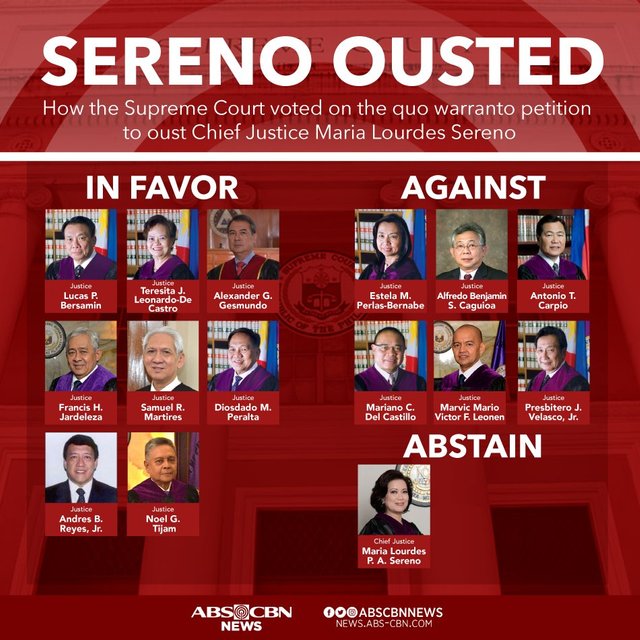The Quo Warranto vs. Sereno: An Explanation from a Student's point of View


On the 11th of May 2018, the Philippine Supreme Court released its decision against their own Chief Justice Maria Lourdes P.A. Sereno.
The vote was 8-6 in favor of the Republic.
The verdict:
Sereno is "found disqualified from and is hereby adjudged guilty of unlawfully holding and exercising the office of the Chief Justice,"
How though? Isn't impeachment the only way to remove a high ranking official as provided under Article 9 section 2 of the 1987 Philippine Constitution?
The high court, voting 9-5 said quo warranto was the proper remedy to unseat Sereno, a historic ruling never before seen in Philippine politics.
So what is "quo warranto"?
In the Philippines, the remedies against usurpers of public office appeared in the 1900s, through Act No. 190. Section 197 of the Act provides for a provision comparable to Section 1, Rule 66 of the Rules of Court:
Section 197. Usurpation of an Office or Franchise - A civil action may be brought in the name of the Government of the Philippine Islands:
- Against a person who usurps, intrudes into, or unlawfully holds or exercises a public civil office or a franchise within the Philippine Islands.
- Against a public civil officer who does or suffers an act which, by the provisions of law, works a forfeiture of his office;
- Against an association of persons who act as a corporation within the Philippine Islands, without being legally incorporated to without lawful authority so to act.
That is to say that the last 6 years of Sereno's term in office as Chief Justice of the Supreme Court has been de facto or without legal basis as she acted as an officer of the State when in fact she wasn't legally appointed. Further, her appointment has been declared void ab initio - which is to say that it was void from the very beginning.
SC Ruling further states, that from the start:
Respondent is Ineligible as a Candidate and Nominee for the Position of Chief Justice.
That's right, ineligible even as simply a candidate/nominee.
Note that all this is new because such a method used is still questionable and Sereno's accusers didn't use impeachment as the main method of removing her from office because impeachment requires a betrayal of public trust.
Did she betray public trust when she forgot to submit her Statement of Assets, Liabilities, and Net worth (SALN) for the year 2003-2006 when she was employed under government service teaching at University of the Philippine College of Law? Or during the period of 2006-2009 when she acted as legal counsel for the Republic of the Philippine on certain cases?
Note here that there is no evidence of any unexplained or ill-gotten wealth, simply the lack of this particular document, unlike in most cases. *cough* Binay anyone?
Her SALN records resumed when she returned to public service 2010 when she was appointed as Associate Justice by then incumbent President Benigno "Noynoy" Aquino, III.
CONCLUSION
The Solicitor General's chosen method of ousting Sereno is ingenious.
The thought behind it is, if impeachment is the only way to remove a member of the Supreme Court, why not invalidate her membership therefore making her a pretender and not an officer?
Through this method, Sereno is deprived of the defenses she could claim under Article 9 Section 2 of the Philippine Constitution.
Is this proper though?
What will be the future repercussions of such an act to the Philippine political system as a whole?
Should we just ignore the Constitution, the highest law of the land, in favor of a rule under Rules of Court?
I mean, come on, that isn't even a statute and statues are only second to the Constitution.
Most importantly, should we ignore the sentiments of the people and let the courts think for us?
See the full text of the Supreme Court's Ruling on former de facto Cheif Justice Maria Lourdes Sereno, HERE.